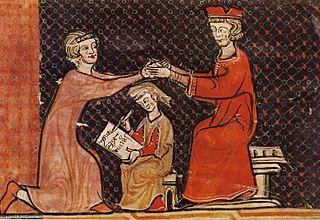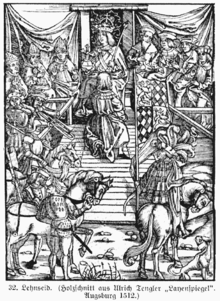
Feudalism, also known as the feudal system, was the combination of the legal, economic, military, cultural and political customs that flourished in medieval Europe between the 9th and 15th centuries. Broadly defined, it was a way of structuring society around relationships that were derived from the holding of land in exchange for service or labour. Although it is derived from the Latin word feodum or feudum (fief), which was used during the Medieval period, the term feudalism and the system which it describes were not conceived of as a formal political system by the people who lived during the Middle Ages. The classic definition, by François Louis Ganshof (1944), describes a set of reciprocal legal and military obligations which existed among the warrior nobility and revolved around the three key concepts of lords, vassals, and fiefs.

An oath of fealty, from the Latin fidelitas (faithfulness), is a pledge of allegiance of one person to another.

A fief was a central element in medieval contracts based on feudal law. It consisted of a form of property holding or other rights granted by an overlord to a vassal, who held it in fealty or "in fee" in return for a form of feudal allegiance, services, and/or payments. The fees were often lands, land revenue or revenue-producing real property like a watermill, held in feudal land tenure: these are typically known as fiefs or fiefdoms. However, not only land but anything of value could be held in fee, including governmental office, rights of exploitation such as hunting, fishing or felling trees, monopolies in trade, money rents and tax farms. There never did exist one feudal system, nor did there exist one type of fief. Over the ages, depending on the region, there was a broad variety of customs using the same basic legal principles in many variations.
Escheat is a common law doctrine that transfers the real property of a person who has died without heirs to the crown or state. It serves to ensure that property is not left in "limbo" without recognized ownership. It originally applied to a number of situations where a legal interest in land was destroyed by operation of law, so that the ownership of the land reverted to the immediately superior feudal lord.

Under the English feudal system several different forms of land tenure existed, each effectively a contract with differing rights and duties attached thereto. Such tenures could be either free-hold, signifying that they were hereditable or perpetual, or non-free where the tenancy terminated on the tenant's death or at an earlier specified period.

A vassal or liege subject is a person regarded as having a mutual obligation to a lord or monarch, in the context of the feudal system in medieval Europe. While the subordinate party is called a vassal, the dominant party is called a suzerain. The rights and obligations of a vassal are called vassalage, while the rights and obligations of a suzerain are called suzerainty. The obligations of a vassal often included military support by knights in exchange for certain privileges, usually including land held as a tenant or fief. The term is also applied to similar arrangements in other feudal societies.
Examples of feudalism are helpful to fully understand feudalism and feudal society. Feudalism was practiced in many different ways, depending on location and time period, thus a high-level encompassing conceptual definition does not always provide a reader with the intimate understanding that detailed historical examples provide.

In medieval and early modern Europe, a tenant-in-chief was a person who held his lands under various forms of feudal land tenure directly from the king or territorial prince to whom he did homage, as opposed to holding them from another nobleman or senior member of the clergy. The tenure was one which denoted great honour, but also carried heavy responsibilities. The tenants-in-chief were originally responsible for providing knights and soldiers for the king's feudal army.

Quia Emptores is a statute passed by the Parliament of England in 1290 during the reign of Edward I that prevented tenants from alienating their lands to others by subinfeudation, instead requiring all tenants who wished to alienate their land to do so by substitution. The statute, along with its companion statute Quo Warranto also passed in 1290, was intended to remedy land ownership disputes and consequent financial difficulties that had resulted from the decline of the traditional feudal system in England during the High Middle Ages. The name Quia Emptores derives from the first two words of the statute in its original mediaeval Latin, which can be translated as "because the buyers". Its long title is A Statute of our Lord The King, concerning the Selling and Buying of Land. It is also cited as the Statute of Westminster III, one of many English and British statutes with that title.

In the Middle Ages, especially under the European feudal system, feoffment or enfeoffment was the deed by which a person was given land in exchange for a pledge of service. This mechanism was later used to avoid restrictions on the passage of title in land by a system in which a landowner would give land to one person for the use of another. The common law of estates in land grew from this concept.
In the law of the Middle Ages and early Modern Period and especially within the Holy Roman Empire, an allod, also allodial land or allodium, is an estate in land over which the allodial landowner (allodiary) had full ownership and right of alienation.
Fēngjiàn was a political ideology and governance system in ancient China, whose social structure formed a decentralized system of confederation-like government based on the ruling class consisting of the Son of Heaven (king) and nobles, and the lower class consisting of commoners categorized into four occupations. The system dated back at least to the Shang dynasty, but was formally coined during the Western Zhou dynasty when the Zhou kings enfeoffed their clan relatives and fellow warriors as vassals. Through the fengjian system, the king would allocate an area of land to a noble, establishing him as the de facto ruler of that region and allowing his title and fief to be legitimately inherited by his descendants. This created large numbers of local domains, which became autonomous states.

Homage in the Middle Ages was the ceremony in which a feudal tenant or vassal pledged reverence and submission to his feudal lord, receiving in exchange the symbolic title to his new position (investiture). It was a symbolic acknowledgement to the lord that the vassal was, literally, his man (homme). The oath known as "fealty" implied lesser obligations than did "homage". Further, one could swear "fealty" to many different overlords with respect to different land holdings, but "homage" could only be performed to a single liege, as one could not be "his man" to more than one "liege lord".

A heerlijkheid was a landed estate that served as the lowest administrative and judicial unit in rural areas in the Dutch-speaking Low Countries before 1800. It originated as a unit of lordship under the feudal system during the Middle Ages. The English equivalents are manor, seigniory and lordship. The German equivalent is Herrschaft. The heerlijkheid system was the Dutch version of manorialism that prevailed in the Low Countries and was the precursor to the modern municipality system in the Netherlands and Flemish Belgium.

In the feudal system of the European Middle Ages, an ecclesiastical fief, held from the Catholic Church, followed all the laws laid down for temporal fiefs. The suzerain, e.g. bishop, abbot, or other possessor, granted an estate in perpetuity to a person, who thereby became his vassal.
An iqta and occasionally iqtaʿa was an Islamic practice of tax farming that became common in Muslim Asia during the Buyid dynasty. Iqta has been defined in Nizam-al-Mulk's Siyasatnama. Administrators of an Iqta were known as muqti or wali. They collected land revenue and looked after general administration. Muqtiʿs had no right to interfere with the personal life of a paying person if the person stayed on the muqtiʿ's land. They were expected to send the collected revenue to the central treasury. Such an amount to be sent was called Fawazil. Theoretically, iqtas were not hereditary by law and had to be confirmed by a higher authority like a sultan or king. However, it was made hereditary in Islamic India by Firoz Tughlaq.

In the kingdom of England, a feudal barony or barony by tenure was the highest degree of feudal land tenure, namely per baroniam, under which the land-holder owed the service of being one of the king's barons. The duties owed by and the privileges granted to feudal barons are not exactly defined, but they involved the duty of providing soldiers to the royal feudal army on demand by the king, and the privilege of attendance at the king's feudal court, the precursor of parliament.

Feudalism as practiced in the Kingdoms of England during the medieval period was a state of human society that organized political and military leadership and force around a stratified formal structure based on land tenure. As a military defense and socio-economic paradigm designed to direct the wealth of the land to the king while it levied military troops to his causes, feudal society was ordered around relationships derived from the holding of land. Such landholdings are termed fiefdoms, traders, fiefs, or fees.
An Afterlehen or Afterlehn(plural: Afterlehne, Afterlehen) is a fief that the liege lord has himself been given as a fief and which he has then, in turn, enfeoffed wholly or partially to a lesser vassal or vassals. The term is German. It is variously referred to in English as a mesne-fief or mesne-tenure, an arriere-fief or subfief, under-tenure or mesnalty.

Feudal duties were the set of reciprocal financial, military and legal obligations among the warrior nobility in a feudal system. These duties developed in both Europe and Japan with the decentralisation of empire and due to lack of monetary liquidity, as groups of warriors took over the social, political, judicial, and economic spheres of the territory they controlled. While many feudal duties were based upon control of a parcel of land and its productive resources, even landless knights owed feudal duties such as direct military service in their lord's behest. Feudal duties were not uniform over time or across political boundaries, and in their later development also included duties from and to the peasant population, such as abergement.








